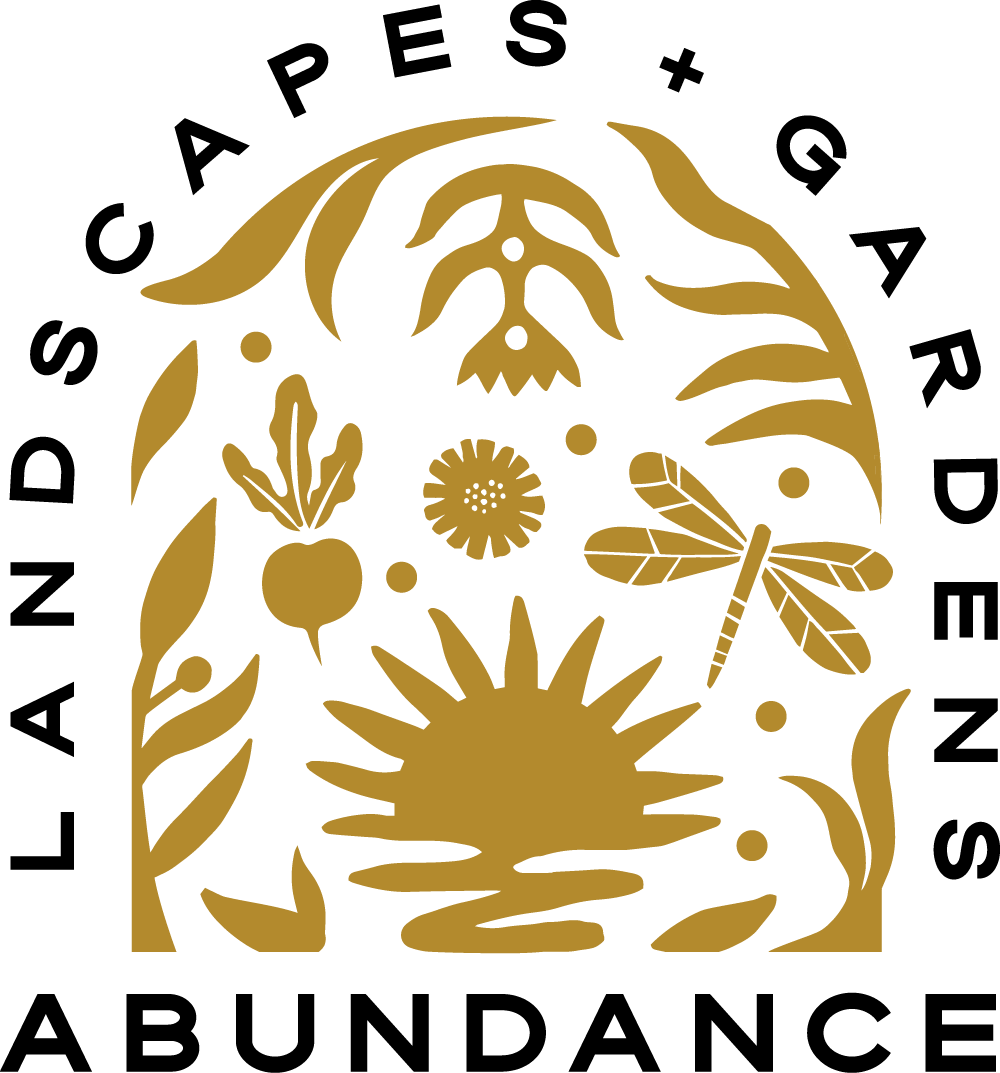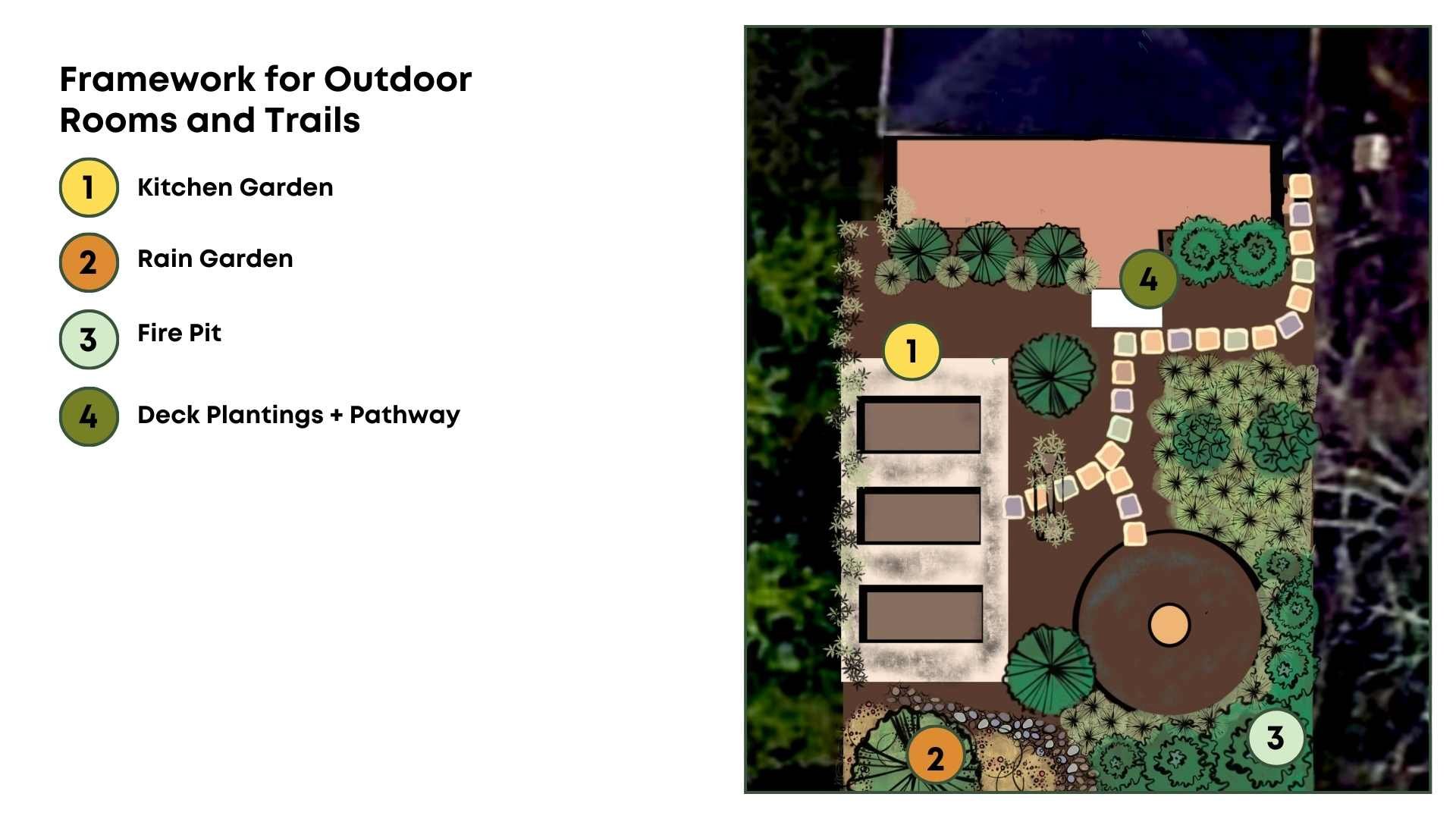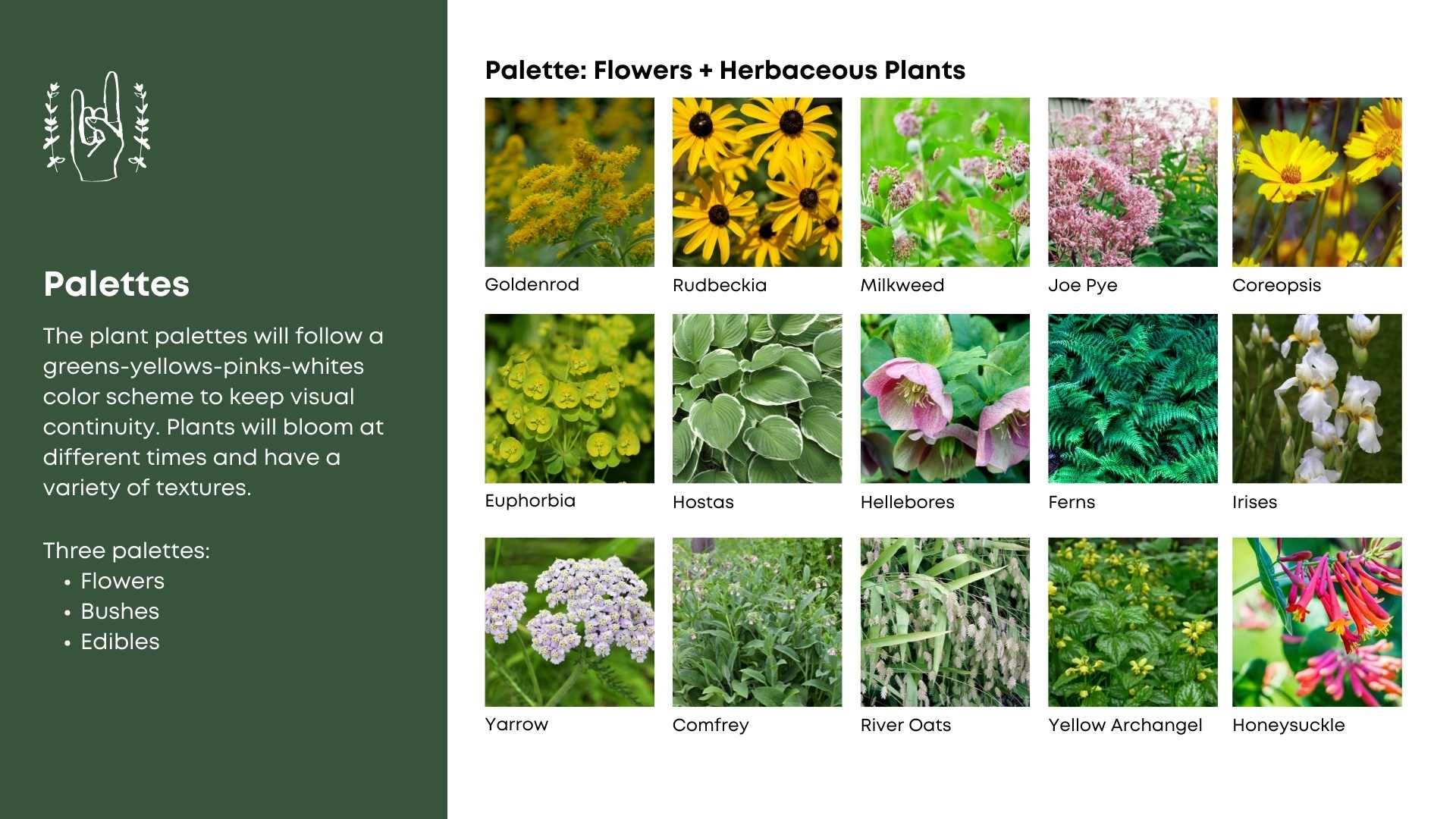Landscape Makeover: From Weedy Backyard to an Edible & Ecological Oasis in West Midtown, Atlanta
Landscape Design and Build Process
Thyme To Party recently finished an exciting project this summer, making over the backyard of a very sweet urban bungalow in West Midtown, Atlanta. With the last of their children flying the coop this August, our clients were ready to start this new chapter of their lives. Enter in: a cozy outdoor oasis where they could host friends and grow an abundance of fresh vegetables and herbs for home-cooked meals all while creating habitat for a thriving ecosystem. The backyard in its current state was simply a rectangle of weedy lawn, so we were thrilled to have the opportunity to transform this blank slate into a productive urban landscape with different outdoor rooms designed for beauty, functionality, and sustainability.
BEFORE: Unusable weed filled grassy area with with extensive erosion.
AFTER: A sustainable landscape that provides space for year-round beauty, gathering, growing food, and a native pollinator habitat.
How do we get started? The process begins with an on-site consultation, discussing with the clients their needs, desires, challenges, habits, observations, etc. Our initial on-site consultations include a thorough site assessment: mapping the sun exposure and patterns throughout the year, evaluating the soil, measuring the size and slopes of the terrain, and evaluating the flow of water and any erosion challenges. It became very clear that this backyard was receiving significant water flow pressure, from the house itself as well as from the next door neighbor’s runoff, so addressing that system was a priority within the design.
The Design. Taking the information from the site assessment in conjunction with the clients’ priorities and preferences, we begin designing a vision for space. For our clients, we create a design presentation that includes an overhead plan, a series of 3D renderings showing what the space will look like with everything in bloom, a breakdown of the space into rooms with their respective functions, and an organized view of the different plant palettes. Our designs are created with the intention of fostering connection between our clients, their visitors (humans and pollinators alike!), and the natural world. With the client’s feedback, we make several tweaks to the design, and finalize the concept for budgeting and install. Here’s a snippet of what our design presentations look like:
Even though it is a relatively small space, this backyard provided a variety of microclimates, enabling a fantastic diversity of plantings and functions. The final installed design featured multiple rooms: The Kitchen Garden, Wildflower Grassland, Rain Garden, Fire Pit, and Woodland Garden.
Allow us to give you a tour:
The Kitchen Garden Room
As a staple of most of our garden installations, we always encourage raised garden beds over in-ground beds. Especially with an archway and slate chip base, it creates a tidy, inviting outdoor room for you to grow high quality, organic vegetables and herbs.
Why raised garden beds? Above-ground beds significantly reduce the weed pressure experiences with in-ground beds, as well as cuts back on certain pest and fungal issues that may be soil-bound. They are also more physically accessible since there is less bending and squatting involved while working with them. And aesthetically, raised beds create a bound and organized space that keeps gardens from ever getting too chaotic or overwhelming. For this design, we located the raised beds in the sunniest part of the yard. We elevated the terrain where the beds would be placed to support proper drainage.
All the Stops including Ecological Water Management! For this project, we used high quality, untreated cedar to guarantee safety and longevity. The archway creates vertical appeal and expands the growing space allowing for higher density planting and support for plants like tomatoes, cucumber, pole beans, etc. We also added a timed drip irrigation system as part of our ecological management plan. The irrigation system is digitally linked to the local radar, so if there is more than a 60% chance of rain, the system will automatically shut off, ensuring beds are not overwatered, while saving clients money on water bills! The raised beds are filled with a high quality soil and compost mix that is plant-ready. We topped the beds off with hoops and netting for protection from squirrels and pests that are so common in late summer. While two beds may not seem like a lot, with proper planning and dense planting, you can actually grow quite an abundance of produce to supplement a family of two. Check out what you can begin growing in your fall garden now!
Wildflower Grassland
A Wildflower Grassland surrounds the Kitchen Garden. Receiving full sun, the grassland is planted with a mix of white cloud muhly, little bluestem, shenandoah switch grass, black eyed susan, cut leaf coneflower, echinacea and purple garden phlox. The grassland is intended to invite a variety of pollinators to the space, to not only support pollination in the vegetable garden but also help with pest control. This area also receives a lot of water pressure from a neighbor’s yard, so the dense, long-rooted plantings should both withstand the runoff as well as slow it down. While working at the raised beds, the gardener can feel fully immersed in this natural ecosystem with the blooms of flowers and bussing of insects all around.
Rain Garden
Huggelkulture Rain Garden in the Making!
Determining the Best Ecological Water Management Solution: There are three downspouts collecting water from the house roof that flow into this backyard. Two of those downspouts were directed and buried to empty into the rain garden, while the other went into the fire pit rain rain garden(see below). We calculated that if it rains just 0.25inches, then about 200 gallons of water is spilling into the backyard. A strong rain of 1 inch would send over 800 gallons into the backyard. The typical rain barrel can only hold around 60 gallons of water, so they really cannot keep up with the amount of rainwater a house roof receives. A rain garden however can capture and hold so much more volume. This site’s rain garden was designed with a capacity of about 600-650 gallons. Within a few days, the water will be absorbed by the plants and soil instead of washing out into the yard or into the neighbor’s yard. Rain gardens are a really wonderful solution to stormwater management. Especially in Atlanta, where the water system is mostly an old combined system, the city is prone to flooding in a matter of minutes. The more water that can be diverted from the sewers, the less pressure the system will receive, so the less flooding there will be.
Final rain garden design.
Rain Garden Build Out with Huggelkultur: This rain garden was first dug out and shaped, with the excavated soil used to regrade the significant slope in the yard in order to create a more level platform for the raised Kitchen Garden beds. The rain garden turned into an impromptu hugelkultur bed. Hugelkultur is a traditional gardening technique from Germany and Eastern Europe (with different cultures having their own versions) and is used widely in permaculture design. Essentially, hugelkultur is a way of layering various decomposing materials under the soil to improve moisture retention and add nutrients in a sustainable manner. Elsewhere on the site’s property, there were stacks of unused rotting firewood, which served as a perfect base to fill the bottom of the rain garden bed. Rotting logs have a sponge-life texture which will soak up the rainwater, as well as easily decompose to provide slow-release nutrients to the plants. On top of the logs, we put in an engineered soil mix for rain gardens (40% compost, 40% topsoil, and 20% sand). The soil was covered with a loose fibrous cedar mulch to distinguish it from the other planted areas as well as suppress unwanted weeds.
This rain garden gets mostly full sun throughout the year, so our plant pallet was chosen accordingly, planting native species that love or - at the minimum - tolerate wet feet including including blacklace elderberry, foam flower, swamp milkweed, swamp hibiscus, bee balm, joe pye weed, echinacea, smooth leaf aster, native irises, goldenrod, and river oats. Check the highlights below of a few of these plants.
Fire Pit Room
Fall Colors Aglow! This is one of our very favorite rooms! Designed for gathering and connecting, the Fire Pit Room features a circular mulched ground surrounded by plants that will really put on a show during the Fall (peak fire pit use time). Because the fire pit is situated under a large Hackberry tree, we decided to mulch the ground instead of doing pebbles or stone surfaces. Since the hackberry will drop a lot of leaves and the debris, these other types of surfaces would require constant cleaning to keep it looking right. The mulched surface choice will be lower maintenance and keep a more organic aesthetic. The planted area is engineered as a rain garden as well, with a downspout gutter flowing into it. As a shady and moist environment, we carefully selected mostly native plants and trees that love water including clethra, white flowering dogwood, dwarf irises, autumn ferns, and a red twig dogwood tree. As our clients spend time with their friends around the fire this fall, they’ll be surrounded by a swirl of reds and oranges.
Woodland Garden
Attached to the Fire Pit is a shaded woodland garden. It is the space that welcomes visitors into the backyard and is the main view from the back deck. As such, we wanted to design the space to be evergreen and have specific winter interest when the majority of the other garden spaces are not as vivacious. With Itea at its foundation, the woodland is structured with various height tiers, drawing the eye fully around the space. Edgeworthia and Hellebores will provide gorgeous blooms in the middle of winter, while a carpet of golden dead nettle and heuchera will suppress weeds and add varying texture. Pennsylvania sedge lines the curve of the flagstone pathway, denoting the separation of space as well as holding mulch in place.
Plant Selection Spotlight
Read more about a couple of our favorite plants we used in this design:
Cut Leaf Coneflower
Also known as “Sochan”, Cut Leaf Coneflower is a native rudebekia with edible leaves. It flowers in the late summer and early fall, and its leaves stay fairly evergreen year-round. This plant is a champ. It can be planted in full sun to full shade and still flower. It tolerates drought, yet loves moist conditions as well. It does spread vigorously, so put it in a spot where it can take over, or easily contained.
White Cloud Muhly
This Muhly cultivar is an alternative to the more common pink cultivar. Muhly is a native, low maintenance and extremely resilient grass. It gets about 3-4ft tall and looks beautiful in mass plantings or on its own. The ivory colored fiber optic-looking seed heads make other colors in the garden pop.
Red Twig Dogwood
Red Twig Dogwood is a native variety of dogwood, with (as the name suggests) red-hued branches. When their leaves drop in the cold, the red branches shine brightly in the landscape providing visual interest throughout the winter. Tolerant of various conditions, they prefer a more moist soil, so they are perfect for integration into a rain garden.
Joe Pye Weed
Joe Pye Weed is an incredible native flower that blankets roadsides throughout North Georgia mountains. It is incredibly resilient and low maintenance, adaptable to varying moisture and sun conditions. There are few flowers that attract more butterflies than this. Blooming mid-late summer, Joe Pye Weed explodes with light pink tufts of tiny flowers all shaping into a globe. We typically like to use the “dwarf” variety of Joe Pye Weed in our landscapes because the traditional cultivar can grow 8-10ft tall!
Black Lace Elderberry
Elderberry is a native shrub-like tree that grows quickly and with little care. The berries ripen mid-summer and are packed with nutrition, often hailed as an immune-boosting supplement to fight off colds. Berries can be dried for teas or used fresh for syrups. The flowers are also used to craft cordials, and are the signature ingredient in St. Germain spirits. It loves wet spots, but can also tolerate very dry conditions. It spreads through runners underground, so it does require a bit of ongoing maintenance to control. However, this feature makes it great for planting on slopes to control erosion. The Black Lace cultivar is a more rare variety that features deep-hued purple lace-like leaves with pink blushed flowers. Cultivars like this do not typically spread as rapidly, yet grow just as easily.













